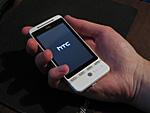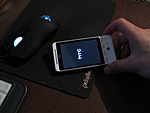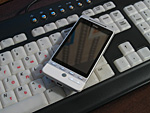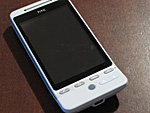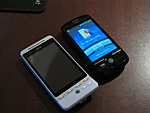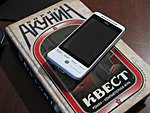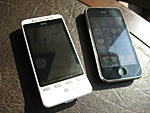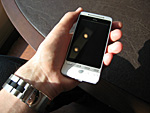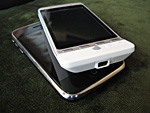|
|
Review of GSM/UMTS-communicator HTC Hero
Live images of the HTC Hero
Table of contents:
- Design, materials
- Size
- Display
- Camera
- Battery time
- Performance
- Connectivity
- Navigation
- Audio
- Text input
- Software
- Competition
- Conclusion
It might sound strange that we consider the first two Android-based devices from HTC to be mere "experiments", but since neither of them has hit the Russian market, we are forced to give the Hero credit for being the company's first phone that will be available worldwide.
The interest many phone makers are showing in Android is both easy and challenging to describe. For Motorola it's the straw they are clinging onto, simply because their own management and policies have driven them into a corner, for Samsung it's all another experiment and a feeler at the same time, but for HTC Android has the potential to become everything. Everyone probably knows that over the last few months the company hasn't been doing as great as before: as expected, their solutions with stratospheric price tags are no longer in demand during the economic meltdown, and they have only one trump left - their brand. So happens that HTC have already grown into an international brand name associated with innovation; it's by no means a rival to Nokia or Sony Ericsson on this front, naturally, but as of today the vast majority of users can differentiate between HTC and other Taiwanese manufacturers.
In light of this fact, choosing Android over Windows Mobile seems to be a reasonable step, plus HTC, seeing and realizing all the risks that may ensue, haven't terminated any of their agreements with Microsoft and continue to churn out WM-powered devices, even though in smaller quantities. Not only is the HTC Hero their first Android-based device, whose is set to land on many markets, but also the firsrt phone to sport HTC's proprietary software we know so well from their Windows Mobile devices: widgets, add-ons, TouchFLO 3D elements and so on. All these features have been carefully tacked on the new platform. But we'll touch open these changes in our review of Android itself, and for now let us take a closer look at the HTC Hero.

Design and materials
I'm really itching to call the white edition of the phone a "soap dish", but thankfully HTC will release a black version of the Hero here, so I'll try to be more tolerant - as HTC's officials claim, the white color scheme of the device won't be available here, although maybe some other colors will come along later on.
Interestingly, all three Android-based communicators from HTC are styled in the same fashion; furthermore, it feels as if they were specifically designed to resemble the sort of gadgetry one might find in a 60's sci-fi movie. To my mind, there is nothing wrong with this approach primarily because no one else offers such quirky designs. Most phones from brand "A" look very much like phones from "B", same holds true for communicators: huge screen, dominating the entire front fascia, no-nonsense shapes, a couple of buttons on the casing and that's about it. Occasionally they throw in some inserts just to make these phones look a bit less conservative, but the gist never changes. So in this sense, the Hero will freshen things up quite a bit.

Looking at the HTC Hero you won't mumble something along the lines of "I could swear I've seen it before". While some of its elements were used in other devices, HTC is the first phone maker that has fused a curved casing, sizable, trackball and matte plastic together in one product.

As for the plastic, can you remember any other latest and greatest phone that is made of simple smooth matte plastic? Personally, I came up with a couple, but all of them were entry-level. Except for the HTC Hero, although it does have a metal insert running along the front plate. While it doesn't seem like much, with all new solutions coming decked out in soft-touch plastic, glossy surfaces and glass, the HTC Hero stands out, and in my opinion it's a very big attraction.
There is another advantage to this material - it's not prone to wear and tear, plus it's hard to smudge, because there is simply nothing you can put a fingerprint on or rub down (at least in the white edition of the device). There are no coatings or extra textured layers, so basically the only thing that can get smudgy in the HTC Hero is its display surface.

We have no gripes with the Hero's build quality - all parts seemed finely tuned and fixed.

Back to the table of contents >>>
Size
The HTC Hero isn't exactly the epitome of "compact" - it stands in one line with the Apple iPhone, HTC Max 4G and is much larger than feature phones or the most pocketable communicators out there, such as the HTC Diamond.
- HTC Hero Ц 112 x 56,2 x 14,3 mm, 135 g
- HTC Touch Diamond 2 Ц 107,8 x 53,1 x 13,7 mm, 117 g
- HTC MAX 4G Ц 113,5 x 61,3 x 13,9 mm, 151 g
- Apple iPhone Ц 115,5 x 62,1 x 12,3 mm, 133 g†

Nevertheless, the Hero still manages to be palm-friendly, all thanks to its relatively narrow casing and the curved design.




The phone readily slips into just about any pocket or purse.
Back to the table of contents >>>
Controls
Housed on the front is the earpiece, covered by a fine grill, right next to it is the service LED (glows in red when the phone is charging or connected to a PC and green when the battery is full) and ambient light sensor that handles the display's backlight.

On the left-hand spine is a sizable volume rocker, but it's mounted flush with the casing, so it's very challenging to use it without looking at list side of the phone, especially while in a call. One thing that they have carried over from HTC's WM phones is that even if the phone's screen is turned off, you can adjust its volume by tapping the volume controls (without having to unlock the device first), which is very convenient, say, when you're listening to music and don't want to take the Hero out of your pocket.

There are no buttons or slots on the right. At the bottom HTC's trademark ExtUSB socket is placed, it's used for charging the phone and plugging in data cables. Sitting on the top is the 3.5 mm audio jack, which makes the Hero one of HTC's few devices that enjoy a separate audio input.



All other controls are mounted below the screen: Call, Home (when you tap and hold it, this key will call up the task manager), Menu and End. A tad below is the search/back button, it's works like this: in most menus, when you press it, you'll get a pop-up window with Google search, but if you press it in some application that allows for searching within the device, it'll use the app's own search engine. For example, if you press it while in the phonebook app, it'll bring up the contact search screen. If you use it in the Market app, the phone will jump to the Application Search menu. As far as I remember, the Hero is the first device to sport such an offbeat, yet logical and very useful solution.

To the left of this key is the phone's trackball used for jumping between the UI's screens, applications, scrolling through pages, texts and browser's screen. I wouldn't call it the most convenient control element I've come across, but nothing too twisted. Honestly, though, I used it only to browse web-pages.


The HTC Hero doesn't have a dedicated camera button - the only way to activate this app is press its icon in the menu; the trackball is used for both focusing and shooting, which isn't the brightest idea, since occasionally instead of going down, the trackball turns under your finger and zooms in instead of taking a shot. Unfortunately, there is no other way to take snaps with the Hero.
Mounted on the battery cover is the lanyard eyelet.

The SIM-card bed is located right under the battery and utilizes a couple of runners for holding the card. The memory card socket (microSD and microSDHC) is found on the left-hand side, but in order to swap cards you'll need to remove the back cover first, thankfully, though, you won't have to turn the Hero off.


Back to the table of contents >>>
Display
The phone enjoys a 3.2 inch touch-sensitive TFT screen (68x45 mm) capable of 480x320 pixel resolution (HVGA). Neither its brightness nor color reproduction were an issue during out quality time with it, however its sharpness couldn't be compared to that of the HTC MAX 4G's or Diamond II's WVGA displays.
The Hero's screen offers decent viewing angles, so that its picture doesn't get distorted no matter what angle you look at it from. It gets washed out under direct sunlight, though, and the picture slides into the black-and-white spectrum, yet it remains readable. Actually, this is one of the Hero display's feats that separate it from other WM-based communicators that become impossible to deal with in the sunlight.
The display also turned out to be reasonably responsive, although still inferior to the Apple iPhone or the Samsung i8000 on this front - occasionally I had to tap it a few times to get a reaction. It's worth mentioning that Android's interface was originally designed for touch-based navigation, and resistive displays, as you know, are more suited for stylus. As yet HTC have shown no sign of ditching this screen technology, but sooner or later they will have to switch to more "finger-friendly" units.
Back to the table of contents >>>
Camera
The communicator comes armed with a 5 MP autofocus-enabled camera, whose lens is placed in the top part of the rear side, sunken into the casing a bit. Unfortunately it doesn't have a cover glass, so the lens slot is a true dust magnet, although it's possible that by its retail release they will fix this issue.

The camera's user interface is as straightforward as it gets: the viewfinder screen shows only the Mode thumbnail (for switching between photo and video) and Gallery shortcut. To call up the settings screen you'll need to tap the Menu button beneath the screen - it'll appear at the bottom with all options popping up in separate windows.
There are both standard and 3:2-type resolutions available:
- 5M (Wide) Ц 2560x1712
- 5 ћ Ц 2560x1920
- 3M (Wide) Ц 2016x1344
- 3ћ Ц 2048x1536
- 1M (Wide) Ц 1280x832
- 1M Ц 1280x960
- L (Wide) Ц 624x416
- L Ц 640x480
Image quality (changes only the size of shots, for the most part):
- Low/li>
- Standard
- High
- Highest
White balance:
- Auto
- Fluorescent
- Incandescent
- Daylight
- Cloudy
Effects
- Black and White
- Sepia
- Negative
Exposure metering:
- Center-weighted
- Integral
- Spot
Much like latest WM-powered communicators, you'll need to confirm all your choices by punching the "Accept" button, which isn't particularly convenient.
Apart from the abovementioned settings, you'll be able to adjust contrast, saturation and sharpness on 5-level scales. Additionally, the Hero will let you set up shutter sound, viewfinder grid, timer and geotagging settings.
All in all, we found that the Hero's image quality was fairly good, on par with the Touch Diamond II or Samsung i8000 - a run-of-the-mill 5 MP solution whose major focus isn't imaging. The phone doesn't have macro mode, which hampers its ability to take closeups - we managed to get it to focus on an object only from 12-15 cm away. Another weak spot of the Hero's camera are documents. Oftentimes it takes around 5-6 shots of each page to get a fairly clean picture that can be recognized on a PC.
 |
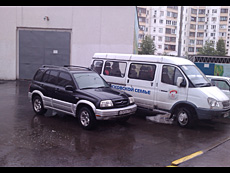 |
| (+) enlarge, 2560x1712, JPEG |
(+) enlarge, 2560x1712, JPEG |
 |
 |
| (+) enlarge, 2560x1712, JPEG |
(+) enlarge, 2560x1712, JPEG |
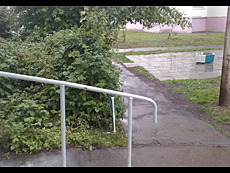 |
 |
| (+) enlarge, 2560x1712, JPEG |
(+) enlarge, 2560x1712, JPEG |
 |
 |
| (+) enlarge, 2560x1712, JPEG |
(+) enlarge, 2560x1712, JPEG |
 |
 |
| (+) enlarge, 2560x1712, JPEG |
(+) enlarge, 2560x1712, JPEG |
 |
 |
| (+) enlarge, 2560x1712, JPEG |
(+) enlarge, 2560x1712, JPEG |
 |
 |
| (+) enlarge, 2560x1712, JPEG |
(+) enlarge, 2560x1712, JPEG |
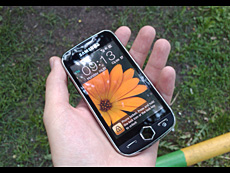 |
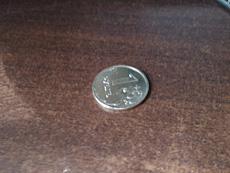 |
| (+) enlarge, 2560x1712, JPEG |
(+) enlarge, 2560x1712, JPEG |
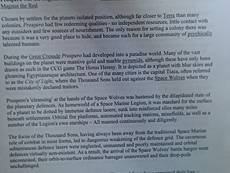 |
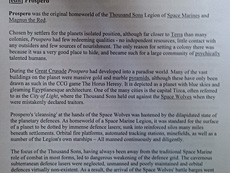 |
| (+) enlarge, 2560x1712, JPEG |
(+) enlarge, 2560x1712, JPEG |
Video
The phone records video in MP4 or 3GP (mp4v or h.263 codecs) at 10 FPS (probably, a limitation of our engineering sample). Sound is recorded with the help of samr codec at 128 kbet/s (based on the data from VLC player) and 16000 Hz, mono. The following resolutions are available:
- CIF Ц 352x288
- L Ц 320x240
- M Ц 176x144
- S Ц 128x96
All settings for the video mode aren't much different from those for still images. There are some additions, though, such as the option to disable sound and limit video size/duration.
The Hero allows the user to zoom in/out regardless of current resolution settings, although you can't do it while shooting - it's mandatory that you stop recording to use the phone's zoom feature. Check out its video quality below.
Back to the table of contents >>>
Battery time
The handset utilizes a 1350 mAh Li-Ion battery, rated for up to 7 hours of talk time (GSM) and 440 hours of standby. Apparently, they have exaggerated its standby time estimations - even if you do nothing with the phone, it'll only last for a week or so.

Our unit of the HTC Hero managed to stay up and running for about 1.5 days with average use (30-40 minutes of calls a day, 10-15 messages, regular mail checks). And if you are into music, its battery time will drop to only one day, although it's not much better than most Windows Mobile devices on this front.
Back to the table of contents >>>
Performance
The Hero is build around Qualcomm MSM 7200A platform, whose CPU runs at 528 Mhz, although its clock rate is changed dynamically, based on what applications are active, from 245 Mhz to 528 Mhz.
The communicator comes armed with 288 Mb of RAM, of which around 120-150 Mb are available for the user's applications. During our quality time there was not a single instance when we felt the Hero was running out of memory.
For storing your personal data, such as music, you can employ the phone's ROM storage (300-400 Mb available after first launch) or a memory card. Our engineering sample, however, had an odd glitch - the camera app refused to save photos to its internal memory, requiring a memory card instead.
The Hero can't playback non-converted video, although as far as playback quality goes, it's a tad better than HTC's latest and greatest WM offerings. One thing of note, though, is that the Hero's video player tends to lag a little or skip frames when watching video in 600x300 resolution. On the bright side, all videos whose resolution matches that of the phone's display were a breeze to watch.
At this stage, the UI's speed is nothing to write home about, being comparable to that of Windows Mobile based communicators, although one could attribute the Hero's overall sluggishness to it being a mere engineering sample.
Back to the table of contents >>>
Connectivity
The phone can tap into GSM (850/900/1800/1900) and UMTS (2100) networks; both EDGE and HSDPA protocols are supported. All these features may be disabled or enabled either via the Settings menu or widgets found on the home screen.


For PC synchronization purposes the Hero utilizes the bundled miniUSB data cable with USB 2.0 interface. Also it sports Bluetooth 2.0+EDR module supporting the following profiles:
- Audio Gateway (AG)
- Audio/Video Control Transport Protocol (AVCTP)
- Audio/Video Remote Control Profile (AVRCP)†
- Generic Audio/Video Distribution Profile (GAVDP)
- Audio/Video Distribution Transport Protocol (AVDTP)
- Advanced Audio Distribution Profile (A2DP)
- Hands-Free Profile 1.5
As you see, the Hero has all the basics covered, although it still lacks some multimedia and PIM-related profiles (it can't beam contacts, for example, or access file systems of other devices). On the other hand, our unit handled a stereo headset with ease, although the audio quality wasn't stunning.
Wi-Fi (802.11b/g). The Hero comes bundled with Wi-Fi connectivity, which worked smoothly during our quality time with the phone. It allows you to set up Wi-Fi sleep mode, static IP only mode and add security certificates.
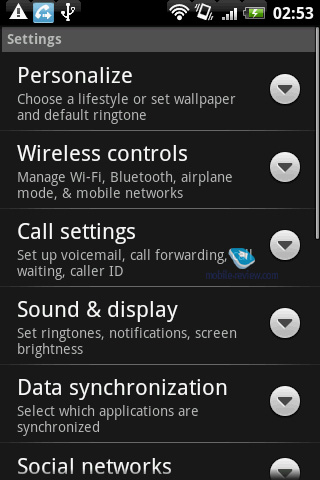

Back to the table of contents >>>
Navigation
The HTC Hero employs Qualcomm's gpsOne chip for navigation purposes. Since the phone doesn't boast any special software for navigation, it has to make do with Google Maps that allow calculate routes (without voice tips), search for streets or specific addresses and places. The main advantage of Google Maps over more sophisticated apps is that its maps are uploaded from the web, meaning that regardless of you are if there is an internet connection, you'll never find yourself without a map. At the same time, being so dependent on data connections makes Google Maps a bit vulnerable - you simply won't be able to use it in offline mode.




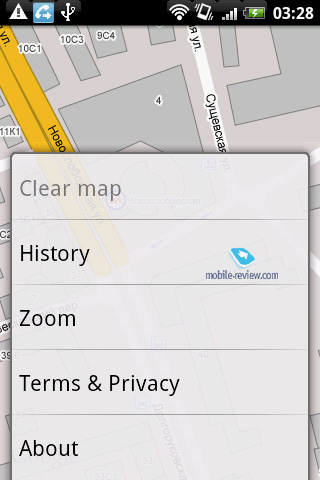
Google Maps is barely usable as a car navigation system, although in most other scenarios you probably won't experience any difficulties with it. The app's latest version now sports the Locator feature that will show your friends' locations on the map.
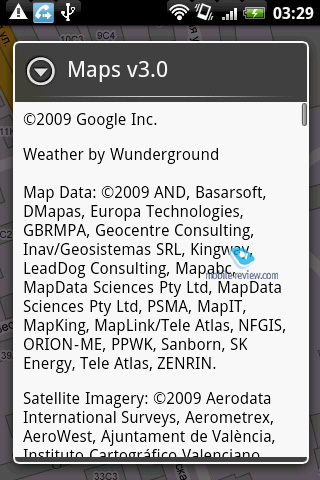
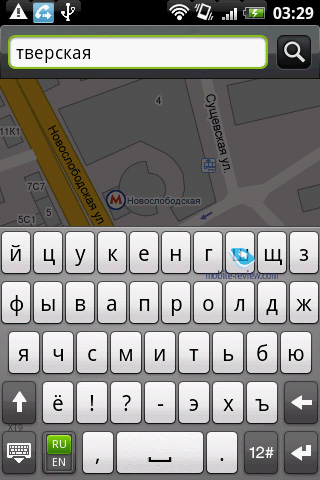
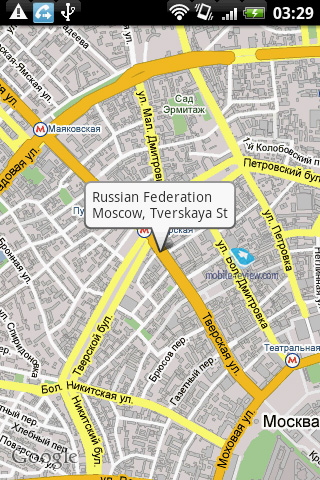
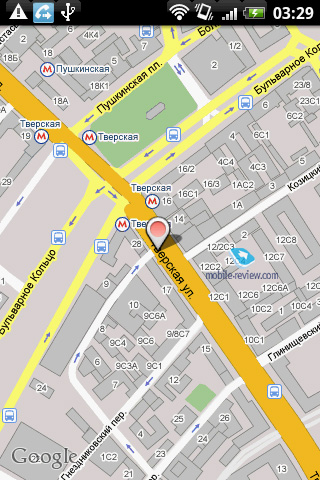
Back to the table of contents >>>
Audio
The presence of a 3.5 mm audio input allows you to listen to your favorite tunes without being limited solely to the bundled headset. As far as music quality goes, I didn't find the HTC Hero to be much different from the Touch HD or Diamond 2. It sounded fairly decent for a casual listener like myself, but music aficionados probably won't be happy with it.

Back to the table of contents >>>
Text input
The HTC Hero boasts a very comfortable on-screen QWERTY keyboard, although it's got its own glitches. For example, while for English and other languages that use the Latin alphabet it allows inputting additional symbols by tapping and holding keys they are bound to, when typing in Russian it requires you to enter the input menu and change the layout. We do hope, however, that they will fix this issue by the time of the phone's retail release.
When working with the keyboard the Hero vibrates on every hit, making the whole experience more seamless and allows users who have just jumped off mechanical keypads to adapt to its on-screen thumbboard. Plus the keyboard can be moved off the screen - there is a special shortcut for this in the bottom left corner.
Back to the table of contents >>>
Software
The communicator runs on Android 1.5 and utilities it's standard user interface with some bits carried over from HTC's very own TouchFLO 3D that can be added onto the home screen. We'll take a closer look at what Android can offer in a separate article.



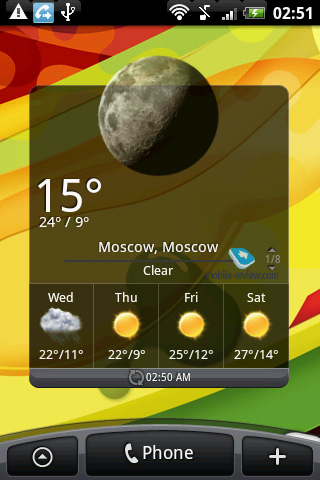

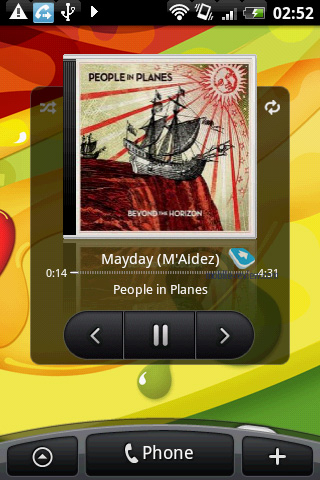
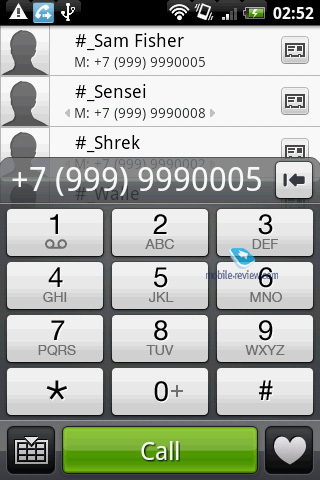
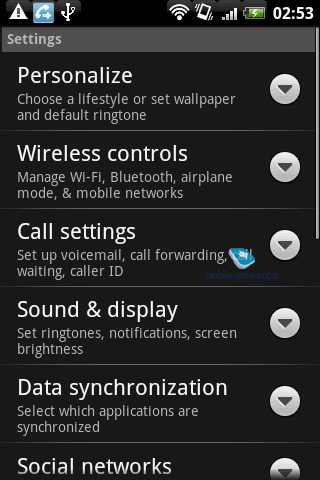
Back to the table of contents >>>
Conclusion
It wouldn't be correct to judge the Hero's reception quality by its engineering sample, but it's worth mentioning that we never had any issues with it on this front, nor did our signal drop off in areas even with so-so coverage. Its earpiece was pretty loud on top of that, and in quiet environments top volume settings would be overkill. The loudspeaker is average volume-wise, however the set of bundled ringtones negates this drawback, as most tunes are pretty loud already. The vibro alert's strength was more than satisfactory as well - I event felt the phone when it was buzzing in my bag.
The Hero is set to land in Russia some time in August at an estimated retail price of 700-750 USD. HTC don't put much stock in this phone as a mass-market offering, for its target audience isn't familiar with its brand-new platform, and therefore it's positioned more as a device for tech geeks. In fact, it's one of those rare cases when the phone maker fully realizes its solution's potential and positions it in an appropriate fashion.
On balance, the Hero does have a lot of potential, being the first Android-powered phone officially available in Russia, which puts it in a league of its own among other latest and greatest offerings of this summer. As far as I'm concerned, the HTC Hero, along with the other two Android-powered communicators, are what a gadget maniac's dreams about the Apple iPhone look like.
Specifications:
- Type: communicator
- Form-factor: candy-bar
- Competition: Samsung i7500
- Materials used: matte plastic, metal
- Operating system: Android 1.5
- GSM/EDGE 850/900/1800/1900 MHz, UMTS/HSDPA 2100
- CPU: 528 Mhz (Qualcomm MSM7200A platform)
- RAM: 288 Mb
- Storage: 512 Mb + microSD memory card slot
- Connectivity: Wi-Fi, Bluetooth 2.0+EDR (A2DP), proprietary ExtUSB (USB 2.0) for charging/synchronization, 3.5mm audio jack
- Display: TFT 3,2Ф with 480x320 pixel resolution (HVGA), auto backlight brightness adjustment
- Camera: 5 MP autofocus-enabled, can capture video in CIF resolution;
- Navigation: gpsOne-based navigation (with A-GPS support)
- Extras: accelerometer
- Battery: detachable 1350 mAh Li-Ion
- Size: 112x56,2x14,3 mm
- Weight: 135 g.
Back to the table of contents >>>
Artem Lutfullin (artem.lutfullin@mobile-review.com)
Translated by Oleg Kononosov (oleg.kononosov@mobile-review.com)
Published — 01 July 2009
Have something to add?! Write us... eldar@mobile-review.com
|
News:
[ 31-07 16:21 ]Sir Jony Ive: Apple Isn't In It For The Money
[ 31-07 13:34 ]Video: Nokia Designer Interviews
[ 31-07 13:10 ]RIM To Layoff 3,000 More Employees
[ 30-07 20:59 ]Video: iPhone 5 Housing Shown Off
[ 30-07 19:12 ]Android Fortunes Decline In U.S.
[ 25-07 16:18 ]Why Apple Is Suing Samsung?
[ 25-07 15:53 ]A Few Choice Quotes About Apple ... By Samsung
[ 23-07 20:25 ]Russian iOS Hacker Calls It A Day
[ 23-07 17:40 ]Video: It's Still Not Out, But Galaxy Note 10.1 Gets An Ad
[ 19-07 19:10 ]Another Loss For Nokia: $1 Billion Down In Q2
[ 19-07 17:22 ]British Judge Orders Apple To Run Ads Saying Samsung Did Not Copy Them
[ 19-07 16:57 ]iPhone 5 To Feature Nano-SIM Cards
[ 18-07 14:20 ]What The iPad Could Have Looked Like ...
[ 18-07 13:25 ]App Store Hack Is Still Going Strong Despite Apple's Best Efforts
[ 13-07 12:34 ]Infographic: The (Hypothetical) Sale Of RIM
[ 13-07 11:10 ]Video: iPhone Hacker Makes In-App Purchases Free
[ 12-07 19:50 ]iPhone 5 Images Leak Again
[ 12-07 17:51 ]Android Takes 50%+ Of U.S. And Europe
[ 11-07 16:02 ]Apple Involved In 60% Of Patent Suits
[ 11-07 13:14 ]Video: Kindle Fire Gets A Jelly Bean
Subscribe
|
